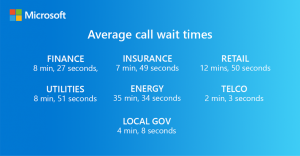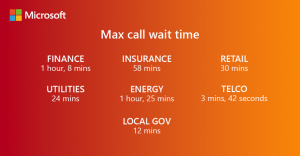When was the last time you had to call a customer service number? Whether you needed to speak to your bank or sort out your energy bill, there’s a chance that you found yourself in an endless loop of hold music. A study commissioned by Microsoft has found that some UK customers are waiting up to 85 minutes to speak to representatives at some of the country’s largest providers of consumer goods and services.
140 calls were made to large UK organisations across various sectors to understand current wait times and potential frustrations that customers across the country are facing.
Findings reveal that the greatest challenge lies in the energy sector. Customers are kept waiting the longest, with an average hold time of 35 minutes and 34 seconds. That’s 133 times slower than the optimal industry standard that has been reported by industry media as 20 seconds. But that’s a breeze compared to the longest wait time we experienced of 85 minutes.
14 loops of Bohemian Rhapsody
“Calling your energy provider and waiting over one hour 25 minutes to speak to a human is equivalent to reading 255 emails, watering 85 plants, or listening to Queen’s Bohemian Rhapsody 14 times,” says Rob Smithson, Microsoft UK’s Business Applications Lead. “The pandemic can no longer be used as a scapegoat for delivering poor service. There are many cost-effective digital solutions to ensure that customer calls and live chat are optimised and efficient. There is a real gap emerging between where businesses see themselves as agents of customer excellence, and the reality of their consumers’ experience”.
In comparison, the best-performing sector in the research—Telco—had an average wait time of 2 minutes and 3 seconds. However, this is still 6 times slower than the advised 20 seconds.
Meanwhile, only around one half (53%) of organisations we called offered an alternative means of communication or a call back service, rather than leaving customers tethered to their phones on hold.
To serve or to sell?
Many organisations took the opportunity to market new services to callers while on hold. Indeed, 18% of organisations called marketed a new service before allowing customers to even reach the main navigation menu. This was most apparent within the Finance and Retail sectors.
The findings also reveal that just 13% of organisations require callers to be current customers to chat with an agent. This means that those exploring new services or simply prospecting could be clogging up the lines for existing customers with urgent queries or struggles with bill payments.
“With consumer patience wearing thin, the UK expects its suppliers to operate with minimal delays, answering telephone lines and live chat services without putting us in a lengthy queue, and certainly not prioritising new business at the expense of existing loyalty,” says Smithson.
How do industries measure up?
With the average wait time varying across industries, Finance and Retail organisations were most likely to state they were experiencing delays due to circumstances beyond their control. And while many financial organisations offered the option of calling customers back, most retail organisations did not.
The average wait time across sectors:

The maximum wait time across sectors:

Navigating to the right place was another challenge on hold, with Local Government and Utilities the industries with the most complex routing menus, taking the longest to get consumers in the queue for an agent.
When is the best time to call?
Across all sectors, the best time of day to call was in the morning when the average wait was the shortest at ten minutes and 7 seconds, while lunchtime was the busiest, with the average wait going up to 14 minutes and 17 seconds.
“The findings underscore the challenges facing consumers and companies alike in the current economic climate, and the need for innovative solutions to ensure a better customer experience,” says Smithson. “Firms must endeavour to value their customers’ time. Using tools that simplify operations and get customers to the answers they are seeking in the fastest time fosters positive customer sentiment and loyalty, and builds valuable brand differentiation.”
About the research
The research, commissioned by Microsoft, was conducted between December 2022 and May 2023 among seven key sectors in the UK, including Finance, Insurance, Retail, Utilities, Energy, Telco and Local Government. Five large organisations were called in each industry across different times of day, with four calls made to each organisation. 140 calls were made in total, measuring aspects such as routing time, automated holding message, and length of wait given versus actual total wait time.





